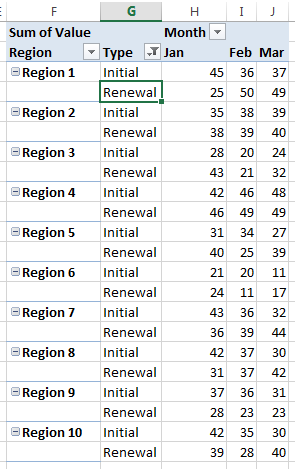

- Calculated items as grandtotal pivot table excel 2013 how to#
- Calculated items as grandtotal pivot table excel 2013 full#
Calculated items as grandtotal pivot table excel 2013 how to#
How to add a Calculated Fieldīefore you can add a Calculated Field you must actually insert a PivotTable, and then with any cell in the PivotTable selected Įxcel 2007 & 2010: Go to the PivotTable Tools: Options tab > Fields, Items & Sets > Calculated FieldĮxcel 2013: Go to the PivotTable Tools: Analyse tab > Fields, Items & Sets > Calculated Field
Calculated items as grandtotal pivot table excel 2013 full#
So if your file needs to go on a crash diet simply feed it some Fat Free Calculated Field Formulas and get rid of all the Full Fat Formulas in your source data. That’s why I call them ‘ Fat Free Formulas’. Whereas if you add that calculation to your PivotTable as a Calculated Field Excel only needs to make that calculation when the PivotTable calls for it, and only to the level of detail seen in the PivotTable. You see, if you add that simple formula to column F it gets calculated for every row, and in large files that can result in your file having a MB blowout which means you could end up with a FAT FILE. Sure it’s easier to just add a simple =E2-D2 formula in cell F2 of the source data then copy it down column F and let the PivotTable add it up, however it’s not the most efficient use of your Excel resources. Quite simply, formulas in your source data are Full Fat Formulas and formulas in Calculated Fields are Fat Free Formulas! Don’t hold me to that as I haven’t tested every scenario! Calculated Fields vs Formulas in the Source Data Whatever you can do in a column in your source data you can do in a Calculated Field…well almost. Tip: Here’s how I visualise Calculated Fields Your PivotTable Field List is simply a list of all of the column labels in your source data (as you can see below), so I like to think of adding a Calculated Field as an alternative to adding another column in your source data. I could add another column in the source data above and calculate my variance for each row of data and then sum it up in my PivotTable, or … drum roll….I could just add a Calculated Field to my PivotTable. But wait, I don’t have a ‘Variance’ column: I’ll create an Actual vs Budget variance report. Let’s look at an example of when you might use a Calculated Field because it’s really not that complicated below is my Actual and Budget sales data which is begging to be Pivoted.

Calculated field formulas can refer to one or more fields. Microsoft Definition: A Calculated Field is a user-defined field in a PivotTable that can perform calculations using the contents of other fields in the PivotTable.


 0 kommentar(er)
0 kommentar(er)
